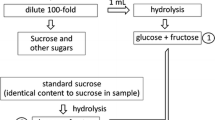Abstract
In this paper, anion exchange chromatography coupled with pulsed amperometric detection has been successfully applied for the fine analysis of isomaltooligosaccharides (IMO) syrups where previous reported methods suffered from a lack of homologue oligosaccharides resolution. These syrups are made of a very complex mixture of glucose oligosaccharides characterized at the same time by their DP value (from 2 to ~15) and linkage types [α-(1–2, 3 or 6) and non-IMO α-(1–4)] and position. A mix of available commercial standards (17 species) was completely separated on a CarboPac PA-100 column at a flow rate of 1 mL min−1 and with a gradient of sodium acetate in 100 mM sodium hydroxide. The method was validated according to calibration curve, precision, recovery tests, limits of detection and quantitation. Calibration curves presented correlation coefficients greater than 0.98. The analytical method has been applied on real syrups, keeping a high performance separation of structurally close molecules and giving, for six determinations, very low relative SD for the available standard molecules (0.3–5.8%). The accuracy of the proposed method was tested by recovery measurements: first by spiking maltose on three different syrups and then by spiking six different sugar standards (20, 50 and 75% of the initial content) on a single syrup. Good recovery results (respectively, 96.5–99.7 and 97.1–102.7%) were found. The method was found sensible with limits of detection (signal-to-noise ratio of 3) between 0.048 and 0.124 μg mL−1 and limits of quantification (signal-to-noise ratio of 10) between 0.159 and 0.412 μg mL−1.


Similar content being viewed by others
References
Gu Q, Yang Y, Jiang G, Chang G (2003) J Hyg Res 32:54–55
Kaneko T, Yokoyama A, Suzuki M (1995) Biosci Biotechnol Biochem 59:1190–1194
Kohmoto T, Fukui F, Takaku H, Machida Y, Arai M, Mitsuoka T (1988) Bifidobacteria Microflora 7:61–69
Rycroft C, Jones M, Gibson G, Rastall R (2001) J Appl Microbiol 91:878–887. doi:10.1046/j.1365-2672.2001.01446.x
Sanz M, Gibson G, Rastall R (2005) J Agric Food Chem 53:5192–5199. doi:10.1021/jf050276w
Delzenne N, Williams C (2002) Curr Opin Lipidol 13:61–67. doi:10.1097/00041433-200202000-00009
Nakakuki T (2005) J Appl Glycosci 52:267–271
Pazur J, French D (1952) J Biol Chem 196(1):265–272
Wang X, Rakshit S (2000) Process Biochem 35:771–775. doi:10.1016/S0032-9592(99)00139-9
Kato N, Suyama S, Shirokane M, Kato M, Kobayashi T, Tsukagoshi N (2002) Appl Environ Microbiol 68:1250–1256. doi:10.1128/AEM.68.3.1250-1256.2002
Yun J, Lee M, Song S (1994) Biotechnol Lett 16:1145–1150. doi:10.1007/BF01020841
Kuriki T, Yanase M, Takata H, Takesada Y, Imanaka T, Okada S (1993) Appl Environ Microbiol 59:953–959
McCleary B, Gibson T (1989) Carbohydr Res 185:147–162. doi:10.1016/0008-6215(89)84030-3
Chen W, Hung T, Lee S (1997) Biotechnol Lett 19:949–951. doi:10.1023/A:1018374612403
Cai Y, Liu J, Shi Y, Liang L, Mou S (2005) J Chromatogr A 1085:98–103. doi:10.1016/j.chroma.2004.11.100
Guddat S, Thevis M, Schänzer W (2005) Biomed Chromatogr 19:743–750. doi:10.1002/bmc.509
Hayakawa K, Ando K, Yoshida N, Yamamoto A, Matsunaga A, Nishimura M et al (2000) Biomed Chromatogr 14(2):72–76. doi:10.1002/(SICI)1099-0801(200004)14:2<72::AID-BMC927>3.0.CO;2-S
Mirmira S, Schreiber M, Guessford S (1993) J Liquid Chromatogr Relat Technol 16(12):2631–2638. doi:10.1080/10826079308019598
Perlné M, Horváth K, Katona Z (2000) Acta Pharm Hung 70(3–6):231–238
Vitek V, Vitek K (1973) Biochem Med 7:119–127. doi:10.1016/0006-2944(73)90107-5
Wolfrom M, Schwab G (1969) Carbohydr Res 9:407–413. doi:10.1016/S0008-6215(00)80025-7
Koizumi K (1996) J Chromatogr A 720:119–126. doi:10.1016/0021-9673(94)01274-1
Robyt J, Mukerjea R (1994) Carbohydr Res 251:187–202. doi:10.1016/0008-6215(94)84285-X
Schmidt F, Enevoldse B (1978) Carbohydr Res 61:197–209. doi:10.1016/S0008-6215(00)84480-8
Goulas A, Fisher D, Grimble G, Grandison A, Rastall R (2004) Enzyme Microb Technol 35:327–338. doi:10.1016/j.enzmictec.2004.05.008
Kubik C, Sikora B, Bielecki S (2004) Enzyme Microb Technol 34:555–560. doi:10.1016/j.enzmictec.2003.11.022
Kuriki T, Yanase M, Takata H, Imanaka T, Okadawa S (1993) J Ferment Bioeng 76(3):184–190. doi:10.1016/0922-338X(93)90005-S
Oguma T, Tobe K, Kobayashi M (1994) FEBS Lett 345:135–138. doi:10.1016/0014-5793(94)00418-8
Tanriseven A, Dogan S (2002) Process Biochem 37:1111–1115. doi:10.1016/S0032-9592(01)00319-3
Nakanishi T, Nomura S, Takeda Y (2006) J Appl Glycosci 53:215–222
Jahnel J, Ilieva P, Frimmel F (1998) Fresenius J Anal Chem 360:827–829. doi:10.1007/s002160050819
Cataldi T, Campa C, De Benedetto G (2000) Fresenius J Anal Chem 368:739–758. doi:10.1007/s002160000588
Koizumi K, Kubota Y, Tanimoto T, Okada Y (1989) J Chromatogr A 464(2):365–373
Campa C, Ous A, Skjåk-Bræk G, Paulsen B, Paoletti S, Christensen B et al (2004) J Chromatogr A 1026:271–281. doi:10.1016/j.chroma.2003.11.045
Fischer D, Geyer A, Loos E (2006) FEBS J 273:137–149. doi:10.1111/j.1742-4658.2005.05050.x
Acknowledgments
This work was jointly supported by the Walloon Region and the company Meurens Natural throughout the FIRST DEI IMOBIOSE research project. We would like to thank Professor Eckhard Loos for providing us the kojioligosaccharides.
Author information
Authors and Affiliations
Corresponding author
Rights and permissions
About this article
Cite this article
Goffin, D., Robert, C., Wathelet, B. et al. A Step-Forward Method of Quantitative Analysis of Enzymatically Produced Isomaltooligosaccharide Preparations by AEC-PAD. Chroma 69, 287–293 (2009). https://doi.org/10.1365/s10337-008-0875-0
Received:
Revised:
Accepted:
Published:
Issue Date:
DOI: https://doi.org/10.1365/s10337-008-0875-0




